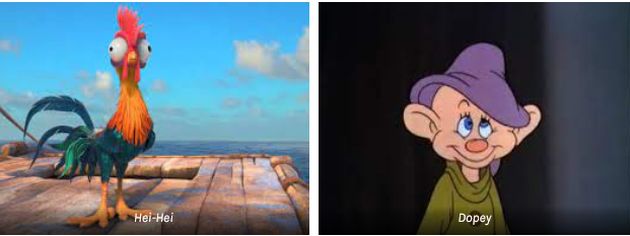While many of us love these films, we need to acknowledge the messages they can give to our children and how these messages can strongly influence them.
![‘Thumper’ in A Bugs Life. / Image via [link]The Additional Needs Blogfather[/link].](https://cms.evangelicalfocus.com/upload/imagenes/6470c32267ade_thumper.jpg) ‘Thumper’ in A Bugs Life. / Image via [link]The Additional Needs Blogfather[/link].
‘Thumper’ in A Bugs Life. / Image via [link]The Additional Needs Blogfather[/link].
Often one of the first forms of mainstream entertainment that children get to experience is the wide range of Disney Pixar movies.
These much loved and well know films are popular viewing for children of all ages and many of us enjoy them into adulthood and look forward to watching them with our own children and grandchildren.
But do these movies help our children to develop a balanced and inclusive view of disability, or can they instead teach children that there is something ‘wrong’ with disabled people, including their disabled peers.
While there are many great positive and affirming examples of disabled characters in Disney Pixar films, think of Renne in ‘Loop’ for example, there are many more characters who are identified as disabled through one of four, sadly all too familiar, tropes:
Examples here include ‘Hei-Hei’, the chicken in Moana, who is clumsy and falls over a lot (signifying Dyspraxia/Developmental Co-ordination Disorder?), shows a lack of intelligence (symbolising Intellectual/Learning Disability?), eats rocks (symbolising PICA?) and is a subject of frustration and pity (see 4, later).
People have even put video clips together of ‘Hei-Hei’s Dumbest Moments’
Another example, even including his name, is ‘Dopey’ one of the dwarves in Snow White And The Seven Dwarves. Often picked on and labelled as stupid, his mutism is also highlighted negatively.
A further, more recent, example is ‘Dory’ from the Finding Nemo/Dory films, whose memory loss is regularly negatively commented on and criticised.
Disabled children often find themselves labelled as ‘stupid’ and are routinely subjected to bullying and abuse as a consequence of this. Disney Pixar characters supporting this negative stereotype are deeply unhelpful.

Another trope often used in films is to give an evil character a disability or difference of some kind. Think of ‘Hook’ in Peter Pan, for example, or ‘Scar’ in Lion King (in both cases their disability/injury being used as their name).
Films can even be quite subtle, but nonetheless effective, in linking ‘disability’ with ‘bad’. The seemingly (at first) cuddly and friendly bear ‘Lotso’ in Toy Story 3 uses a walking cane, and this gives us a clue of what is to come, as inevitably this character turns out to be an evil baddy.

The ‘evil’ characters mentioned above are scary because they are evil, but there is another way that films use disability to be scary, just through depicting the disability itself as being frightening.
An example of this is the grasshopper ‘Thumper’ in A Bugs Life. ‘Thumper’ is portrayed as having some kind of brain injury or mental health condition, is sometimes shackled, and is used to terrify the ants into submission.
We see him first near the beginning of the film when ‘Hopper’, the leader of the grasshoppers, announces that “…someone could get hurt” before clicking his fingers to summon Thumper, who is held in a shackle by two other grasshoppers as he is used to frighten the ants.
This imagery tells children that someone with a disability is to be feared, that they might hurt you, that they are to be avoided at all costs.
There is a fourth ‘trope’ out there that crops up time and again in these movies, and that is the one where disabled characters are portrayed as victims, only to be pitied by the rest of society.
A classic example of this is ‘Quasimodo’ in The Hunchback Of Notre Dame, where he is feared, hated, and pitied by the other characters, and although he eventually is accepted for who he is at the end of the film, it is the Captain of the Guard that marries the Princess, not Quasimodo.
More recently, the theme of disabled characters being a victim or to be pitied is seen in various toys in the Toy Story series, where they are either rejected for being broken (‘Wheezy’, the asthmatic penguin who has lost his squeaker, or even ‘Woody’ when he has a ripped arm ), or are made victims of the cruelty of Sid, the boy next door.

Again, this teaches children that disabled people cannot amount to anything, they are never going to be the ‘hero/heroine’, they are only to be pitied and treated as victims; rejected.
While many of us love these films, we do need to acknowledge the messages that they can give to our children and how these messages can strongly influence them in their emerging understanding of disability and their disabled peers.
I’m not suggesting that we boycott these movies, but that we help our children to understand the issues raised here and to form a better, more inclusive and balanced view of disability.
Happy watching,
Mark Arnold, Director of Additional Needs Ministry at Urban Saints. Arnold blogs at The Additional Needs Blogfather. This article was re-published with permission.

Las opiniones vertidas por nuestros colaboradores se realizan a nivel personal, pudiendo coincidir o no con la postura de la dirección de Protestante Digital.
Si quieres comentar o